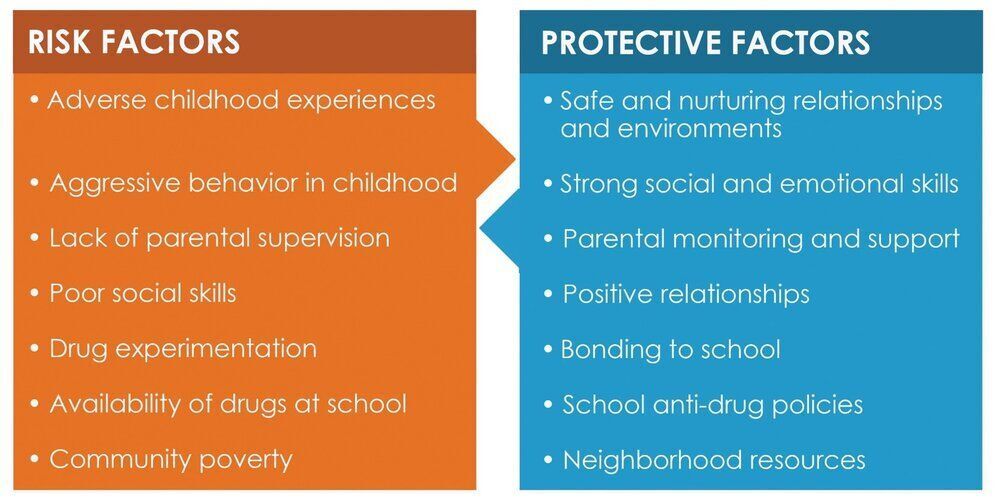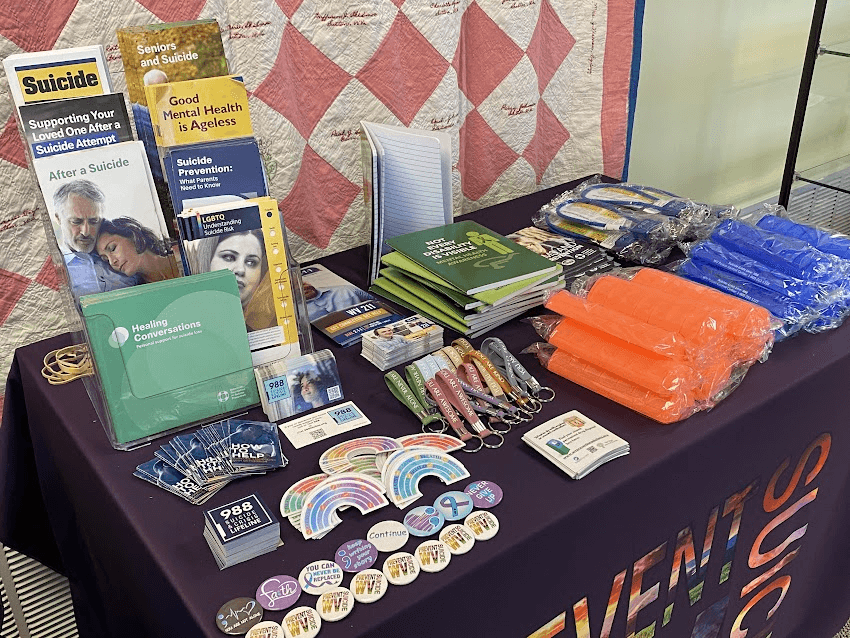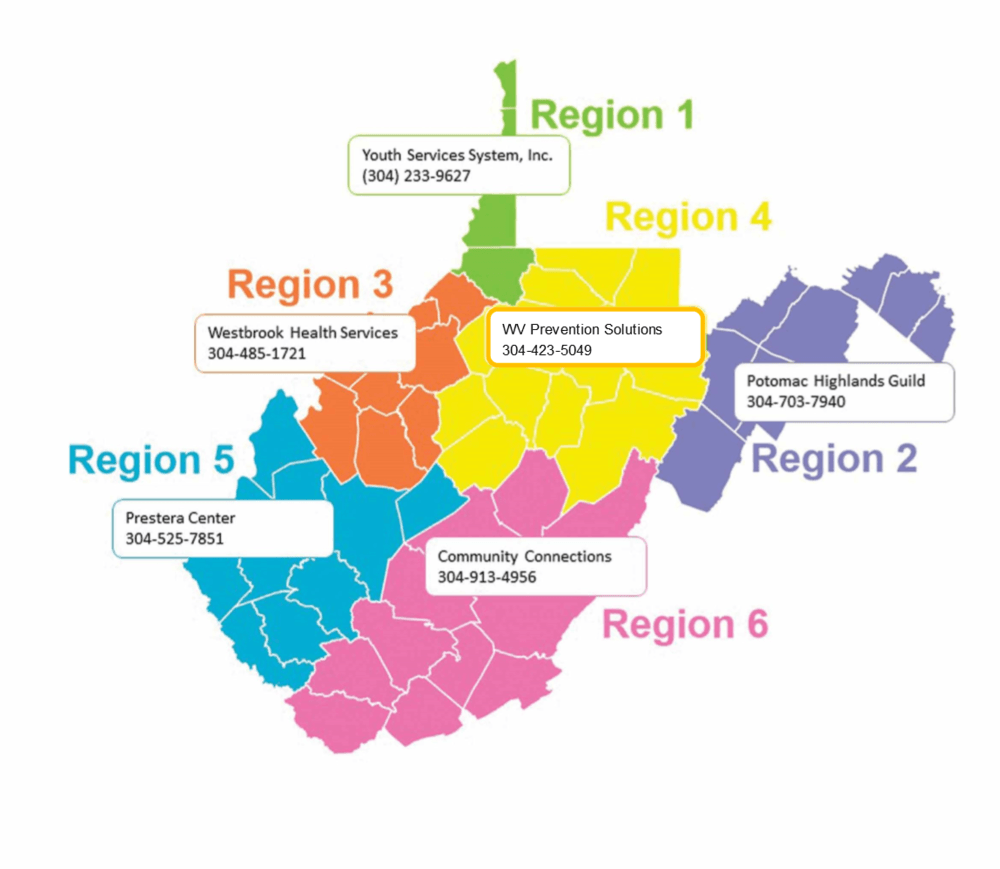Prevention 101
West Virginia has developed a prevention infrastructure to implement and support prevention efforts in the state. The Prevention Infrastructure in West Virginia includes:
- Six regional Prevention Lead Organizations (PLOs)
- County coalitions under the PLOs
- Partnerships for Success (PFS) Coordinators
- SOR Coalition Engagement Specialists
- SOR Adult Suicide Intervention Specialists
- Garrett Lee Smith (GLS) Youth Suicide Intervention Specialists and Prevent Suicide WV
Prevention Lead Organizations are located in six regions throughout the state. These leads have extensive training and experience related to prevention, and coordinate efforts among county coalitions and other specialists. They provide services such as information dissemination, education, alternatives, problem ID and referral, community-based processes, and environmental strategies. They are trained in the Strategic Prevention Framework and have experience using data to guide prevention decisions—from identifying which substance use problems to address in a community, to choosing the most appropriate ways to address these problems, to determining whether selected interventions and strategies are making progress in meeting prevention needs.
West Virginia Prevention Solutions is the Region 4 Prevention Lead Organization in the prevention infrastructure. Our staff are trained in prevention best practices and most are certified Prevention Specialists.
WV Prevention First from Help and Hope West Virginia on Vimeo.
How Do We “Do Prevention”?
Prevention consists of many practices that create positive change in our communities. Similar to other chronic disorders, factors can affect whether we are more susceptible to the disease of addiction. Certain biological and environmental factors can increase our vulnerability. Prevention programs boost protective factors and eliminate or reduce risk factors. There is strong scientific evidence that supports the effectiveness of prevention programs.
Evidence-based prevention interventions can:
- prevent use or delay early use
- stop the progression from first use to misuse to substance use disorder (including addiction)
Prevention is cost-effective. Evidence-based prevention interventions can decrease costs related to substance-related crime, lost work productivity, and related health care costs. These are categorized by SAMHSA (Substance Abuse and Mental Health Services Administration) as the Six CSAP (Centers for Substance Abuse Prevention) Strategies.
SAMHSA’s Six CSAP Strategies
-
Information Dissemination
This strategy provides awareness and knowledge of the nature and extent of alcohol, tobacco and drug use, abuse and addiction and their effects on individuals, families and communities. It also provides knowledge and awareness of available prevention programs and services. Information dissemination is characterized by one-way communication from the source to the audience, with limited contact between the two. Examples of activities conducted and methods used for this strategy include (but are not limited to) the following:
- Clearinghouse/information resource center(s);
- Resource directories;
- Media campaigns;
- Brochures;
- Radio/TV public service announcements;
- Speaking engagements;
- Health fairs/health promotion; and
- Information line.
-
Education
This strategy involves two-way communication and is distinguished from the Information Dissemination strategy by the fact that interaction between the educator/facilitator and the participants is the basis of its activities. Activities under this strategy aim to affect critical life and social skills, including decision-making, refusal skills, critical analysis (e.g., of media messages) and systematic judgment abilities. Examples of activities conducted and methods used for this strategy include (but are not limited to) the following:
- Classroom and/or small group sessions (all ages);
- Parenting and family management classes;
- Peer leader/helper programs;
- Education programs for youth groups; and
- Children of substance abusers groups.
-
Alternative Activities
This strategy provides for the participation of target populations in activities that exclude alcohol, tobacco and other drug use. The assumption is that constructive and healthy activities offset the attraction to, or otherwise meet the needs usually filled by alcohol, tobacco and other drugs and would, therefore, minimize or obviate resort to the latter. Examples of activities conducted and methods used for this strategy include (but are not limited to) the following:
- Drug free dances and parties;
- Youth/adult leadership activities;
- Community drop-in centers; and
- Community service activities.
-
Environmental Strategies
This strategy establishes or changes written and unwritten community standards, codes and attitudes, thereby influencing incidence and prevalence of the abuse of alcohol, tobacco and other drugs used in the general population. This strategy is divided into two subcategories to permit distinction between activities which center on legal and regulatory initiatives and those that relate to the service and action oriented initiatives. Examples of activities conducted and methods used for this strategy shall include (but not be limited to) the following:
- Promoting the establishment or review of alcohol, tobacco and drug use policies in schools;
- Technical assistance to communities to maximize local enforcement procedures governing availability and distribution of alcohol, tobacco, and other drug use;
- Modifying alcohol and tobacco advertising practices; and
- Product pricing strategies.
-
Community Based Processes
This strategy aims to enhance the ability of the community to more effectively provide prevention and treatment services for alcohol, tobacco and drug abuse disorders. Activities in this strategy include organizing, planning, enhancing efficiency and effectiveness of services implementation, inter-agency collaboration, coalition building and networking. Examples of activities conducted and methods used for this strategy include (but are not limited to) the following:
- Community and volunteer training, e.g., neighborhood action training, training of key people in the system, staff/officials training;
- Systematic planning;
- Multi-agency coordination and collaboration;
- Accessing services and funding; and
- Community team-building.
-
Problem Identification and Referral
This strategy aims at identification of those who have indulged in illegal/age-inappropriate use of tobacco or alcohol and those individuals who have indulged in the first use of illicit drugs in order to assess if their behavior can be reversed through education. It should be noted, however, that this strategy does not include any activity designed to determine if a person is in need of treatment. Examples of activities conducted and methods used for this strategy include (but are not limited to) the following:
- Employee assistance programs;
- Student assistance programs; and
- Driving while under the influence/driving while intoxicated education programs.



